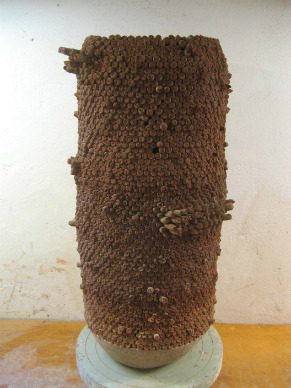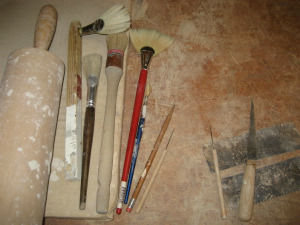Interview with Jim Kraft

What was the starting point in your investigation (research) with earthenware clay?
When I set up my studio, I bought an electric kiln which satisfied my needs as I was interested in making objects that were not meant to be functional or to be displayed outdoors. I did not want to cover the clay with a glaze; I wanted the earthen colors of the clay to be prominent.
In what techniques do you usually work and what materials do you use?
My work is solely hand-built. I roll 25# slabs of clay by hand. I use a clay extruder to make my coils .I imbed dry colorants in both the slabs and the coils. I throw dry colorants on the ware boards as I roll the slabs, the moist clay picks up the dry materials. Depending on what series I’m working on I build the vessel forms using cut up or torn slab pieces and twisted off sections of coils. I use earthenware clay in either a buff or a red color. After the piece is bisqued I brush on a black/brown slip, I let that dry and the next day I wipe it off. It stays in the cracks and crevasses. Then I brush on a clear glaze. I let that dry and wipe it off the next day. I leave enough to give it life but not shine. I want the surface of the clay to absorb light, not to reflect it. This is a building up of the surface, layering, as you might do in printmaking or painting. Then I fire it a final time.
What is your present project, what’s its history and how do you make the pieces? Tell us more about the process.
Currently, I’m building vessel forms using short torn pieces of clay coils and stacking them, like cord wood. The end of each torn piece faces the viewer. It’s like building with wine bottle corks or cigar butts, but end up looking more like natural, organic objects such as bird nests, bee hives or tree stumps. The trick is finding the place where they don’t look like any of those things but allude to any and all of them. However, I always want them to read as vessel forms, something that contains.

Unfired piece - View his works
Do you remember your early works, how it all started?
When I originally went to college in the Upper Peninsula of Michigan, I took all the art classes available. Printmaking, drawing, photography, cinematography, jewelry making, ceramics. It was ceramics that sparked me ten times more that any of the other disciplines. Although I learned to use, the potters wheel it was hand-building that attracted me. My forms then were as organic as they are today. I eventually moved to Seattle and studied at a small private art school called The Factory of Visual Art. After that, I attended the University of Washington then began working at home in my own studio.

You say that your work connects you with past cultures who used the same materials to make vessels for ceremony or everyday use. How important is this connection for you?
I recently saw Werner Herzog’s film CAVE OF FORGOTTEN DREAMS, about the caves in France containing wall paintings done thirty thousand year ago. Also discussed were objects, weapons and vessels made during these times. It thrills me to know that today I’m “making” things my predecessors made so very long ago.
Where can we find you and your works in the next future?
I’ve never been one to have a plan. I just keep working.
Give a piece of advice for the young ceramic artists.
Let the work come from your gut, not so much from your head. I feel art is another language, not one of the words and ideas, but a visual language that speaks to your senses. Also, make what you want to make, not what you think you should make.
“My work in clay has been a succession/evolution of ideas over a thirty year period. I take certain elements that “work” in one series and often build the next series based on those elements. That could include the color of the clay body, the colors of the surface treatment, the texture of the surface, the form or the building technique.
I enjoy working with the idea in mind of smaller parts making up the whole. Tiles covering a wall. Vessels made of coil and brick-like pieces, or cut and torn clay parts that make a vessel look basket-like. The vessel form appeals to me on a level that I don’t understand. It is a sort of mystery. When I am out in the world and see such a form, I am immediately drawn to it. As much as I am concerned with surface texture it is ultimately the simple form of a vessel that appeals to my eye.
I would like to think my work, and the act of making the work, connects me with past cultures who used the same materials to make vessels for ceremony or everyday use. I like the idea of being a part of the long history of people making things with their hands.” Jim Kraft
By Vasi Hirdo.
Published in Ceramics Now Magazine Issue 1.
Visit Jim Kraft’s website.
View Jim Kraft’s profile on Ceramics Now.
